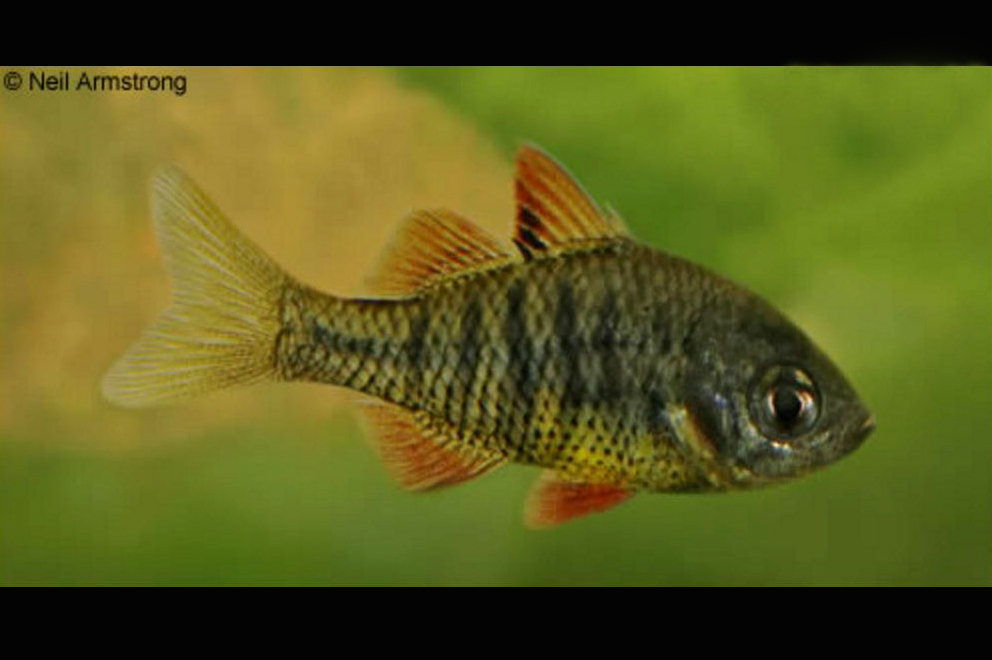Pennyfish, Denariusa australis (Steindachner 1867)

Pennyfish, Denariusa australis. Source: Neil Armstrong. License: All rights reserved
The Pennyfish has a scattered distribution in the Northern Territory and north Queensland and is the smallest glassfish in Australia.
Pennyfish, Denariusa australis (Steindachner 1867)
More Info
|
Distribution |
Occurs in four very disjunct populations in northern Australia from the Daly River to Groote Eylandt, Northern Territory, the Jardine River, and Murray Swamps, near Cardwell, Queensland. The species also occurs in the Fly River and Bensbach River drainages in southern Papua New Guinea. Inhabits small freshwater streams and flooded swampy wetlands in areas of dense aquatic vegetation. |
|
Features |
Dorsal fin VIII, I, 9-10; Anal fin III, 7-9; Pectoral fin 9-10 Body deep and compressed; greatest body depth 41.7-44 % SL; head length 34.8 to 40.0% SL; snout length 7.5 to 8.3% SL; eye large, diameter 12.3 to 14.6% SL; convex forehead profile; mouth relatively small, not reaching back to eye; gill rakers rudimentary, about 6 to 9 on lower limb of first gill arch; supraorbital spine absent; hind margin of preopercle strongly serrate; nasal spine absent; preorbital ridge smooth; suborbital smooth; preorbital edge with 9 to 12 serrae; preopercular ridge usually smooth, occasionally with 1 to 3 weak serrae; lateral line weakly developed or absent with 0-4 pored scales. Scales large, cycloid; vertical scale rows 24-26; horizontal scale rows 11; cheek scale rows 2. Dorsal fin deeply notched, originates behind origin of ventral fins; height of first dorsal fin 25.8 to 29.3% SL; 2nd and 3rd dorsal spines about equal in length; anal and dorsal fins with scaly basal sheath; pectoral fins of moderate size; ventral fins large; caudal fin moderately forked with rounded tips. |
|
Size |
To 4.5 cm SL; commonly to 3.5 cm. |
|
Colour |
Semi-transparent with dusky scale margins and a series of six narrow dark vertical bars on side of body; fins transparent to straw coloured; dorsal and anal fins with a dusky rear edge. |
|
Feeding |
Feeds mainly on aquatic insects and micro-crustaceans. |
|
Biology |
Pennyfish are sexually mature at the end of their first year. Breeding generally occurs in flooded swampy lagoons during the wet season. |
|
Remarks |
Although this species is often referred to as Denariusa bandata, the correct name is Denariusa australis. |
|
Similar Species |
This species is easily distinguished from others in the family in its small size, in having a robust shape, a barred pattern, lower pectoral-fin ray and gill raker counts, and in the absence of a supraorbital spine. |
|
Species Citation |
Apogon australis Steindachner 1867, Sitzungsberichte der Akademie der Wissenschaften in Wien. Mathematisch-Naturwissenschaftliche Klasse 55(1): 10. Type locality: Fitzroy River, Rockhampton, Queensland. |
|
Author |
Bray, D.J. 2019 |
|
Resources |
Pennyfish, Denariusa australis (Steindachner 1867)
References
Allen, G.R. 1989. Freshwater Fishes of Australia. Neptune, New Jersey : T.F.H. Publications 240 pp., 63 pls. (as Denariusa bandata)
Allen, G.R. & Burgess, W.E. 1990. A review of the glass-fishes (Ambassidae) of Australia and New Guinea. Records of the Western Australian Museum, Supplement 34: 139-206 See ref online, open access (as Denariusa bandata)
Allen, G.R. & Hoese, D.F. 1980. A collection of fishes from Cape York Peninsula, Australia. Journal of the Royal Society of Western Australia 63: 53–61. (as Denariusa bandata) See ref at BHL
Allen, G.R., Midgley, S.H. & Allen, M. 2002. Field Guide to the Freshwater Fishes of Australia. Perth : Western Australian Museum 394 pp. (as Denariusa bandata)
Allen, G.R., Storey, A.W. & Yarrao, M. 2008. Freshwater Fishes of the Fly River Papua New Guinea. Tabubil, Papua New Guinea : Ok Tedi Mining 216 pp.
Cook, B.D. & Hughes, J.M. 2010. Historical population connectivity and fragmentation in a tropical freshwater fish with a disjunct distribution (pennyfish, Denariusa bandata). Freshwater Science, 29(3): 1119-1131 https://doi.org/10.1899/09-087.1
Cook, B.D., Unmack, P.J., Huey, J.A. & Hughes, J.M. 2014. Origin of relict populations of freshwater fishes in northern Australia with common disjunct distributions (Pseudomugil gertrudae, Denariusa australis and Melanotaenia maccullochi). Freshwater Science 33:263–272. https://doi.org/10.1086/674936
Gon, O. & Herzig-Straschil, B. 1996. Taxonomic status of Steindachner's Apogon australis and Apogonichthys gillii (Teleostei, Apogonidae). Copeia 1996(4): 1029-1031 https://www.jstor.org/stable/1447671
Hitchcock, G. 2002. Fish Fauna of the Bensbach river, southwest Papua New Guinea. Memoirs of the Queensland Museum 48(1): 119-122. (as Denariusa bandata)
Larson, H.K. & Martin, K.C. 1990. Freshwater Fishes of the Northern Territory. Northern Territory Museum of Arts and Sciences Handbook Series Number 1. Darwin : Northern Territory Museum of Arts and Sciences 102 pp. 73 figs. (as Denariusa bandata)
Larson, H.K., Williams, R.S. & Hammer, M.P. 2013. An annotated checklist of the fishes of the Northern Territory, Australia. Zootaxa 3696(1): 1-293
Leggett, R. & Merrick, J.R. 1987. Australian Native Fishes for Aquariums. Artarmon : J.R. Merrick Publications 241 pp. 142 figs. (as Denariusa bandata)
Merrick, J.R. & Schmida, G.E. 1984. Australian Freshwater Fishes Biology and Management. Sydney : J.R. Merrick 409 pp. figs 280 col. figs. (as Denariusa bandata)
Pusey, B.J., Kennard, M.J. & Arthington, A.H. 2004. Freshwater Fishes of North-eastern Australia. Collingwood, Victoria : CSIRO Publishing 684 pp. (as Denariusa bandata)
Pusey, B.J., Kennard, M.J. & Bird, J. 2000. Fishes of the dune fields of Cape Flattery, northern Queensland and other dune systems in north-eastern Australia. Ichthyological Exploration of Freshwaters 11(1): 65-74. (as Denariusa bandata)
Pusey, B.J., Burrows, D.W., Kennard, M.J., Perna, N., Unmack, P.J., Allsop, Q. & Hammer, M.P. 2017. Freshwater fishes of northern Australia. Zootaxa 4253(1): 1-104. http://dx.doi.org/10.11646/zootaxa.4253.1.1
Steindachner, F. 1867. Über einige Fische aus dem Fitzroy-Flusse bei Rockhampton in Ost-Australien. Sitzungsberichte der Akademie der Wissenschaften in Wien. Mathematisch-Naturwissenschaftliche Klasse 55(1): 9-16 figs 1-2 (Description of Denariusa australis)
Unmack, P.J. 2001. Biogeography of Australian freshwater fishes. Journal of Biogeography 28: 1053-1089 https://doi.org/10.1046/j.1365-2699.2001.00615.x
Whitley, G.P. 1948. Studies in Ichthyology No. 13. Records of the Australian Museum 22(1): 70-94 figs 1-11 DOI 10.3853/j.0067-1975.22.1948.592, open access (as Denariusa bandata)




